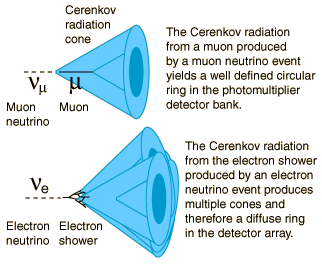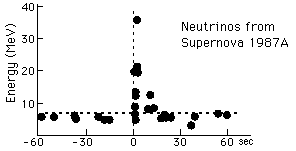Detection of Neutrinos
The first experimental observation of the neutrino interacting with matter was made by Frederick Reines, Clyde Cowan, Jr, and collaborators in 1956 at the Savannah River Plant in South Carolina. Their neutrino source was a nuclear reactor (it actually produced antineutrinos from beta decay).
 | Modern neutrino detectors at IMB in Ohio and Kamiokande in Japan detected neutrinos from Supernova 1987A. A new neutrino detector at Sudbury, Ontario began collecting data in October of 1999. Another Japanese neutrino detector called Super Kamiokande became operational in April 1996. |
An early set of experiments with a facility called the solar neutrino telescope, measured the rate of neutrino emission from the sun at only one third of the expected flux. Often referred to as the Solar Neutrino Problem, this deficiency of neutrinos has been difficult to explain. Recent results from the Sudbury Neutrino Observatory suggest that a fraction of the electron neutrinos produced by the sun are transformed into muon neutrinos on the way to the earth. The observations at Sudbury are consistent with the solar models of neutrino flux assuming that this "neutrino oscillation" is responsible for observation of neutrinos other than electron neutrinos.
| Cherenkov Radiation |
Reference
McDonald, Klein & Wark
| HyperPhysics***** Quantum Physics | R Nave |



